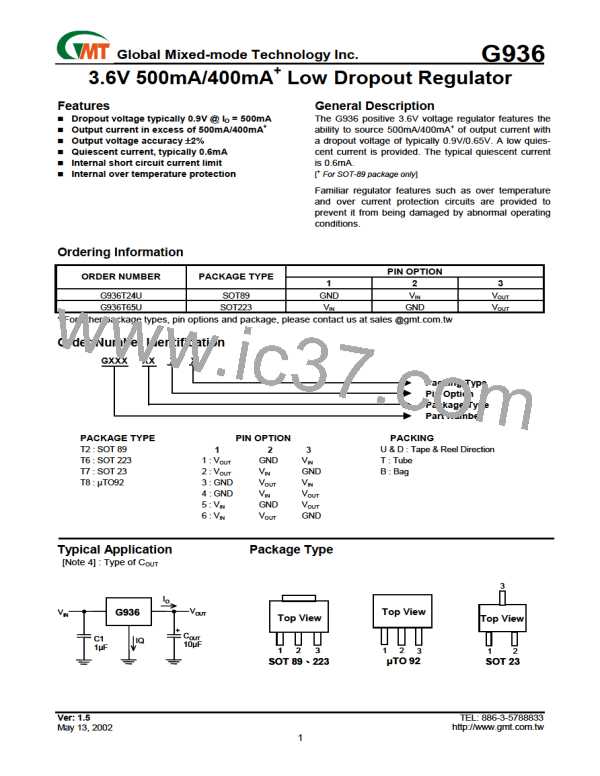Global Mixed-mode Technology Inc.
G936
(Note 1)
(Note 1)
Absolute Maximum Ratings
Operating Conditions
Input Voltage……………………………….………….10V
Power Dissipation Internally Limited
Input Voltage………………………………………4V ~ 7V
Temperature Range………………….…0°C ≤ TJ ≤125°C
(Note2)
Maximum Junction Temperature………….………130°C
Storage Temperature Range..….…-65°C ≤ TJ ≤+150°C
Lead Temperature, Time for Wave Soldering
SOT 89, SOT 223 Package……………….…..260°C, 4s
Continuous Power Dissipation (TA = + 25°C)
SOT 89(1)……………..………………………….….0.42W
SOT 223(1)………………….……………………….0.65W
Note (1): See Recommended Minimum Footprint.
Electrical Characteristics
VIN = 5V, IO = 500mA/400mA+, CIN=1µF, COUT =10µF. All specifications apply for TA = TJ = 25°C. [Note 3]
PARAMETER
Output Voltage
CONDITIONS
MIN
3.528
TYP
3.6
MAX
3.672
UNITS
V
10mA < IO <500mA
10mA < IO <400mA+
Line Regulation
4V < VIN < 7V, IO = 50mA
10mA < IO <500mA
5
58
50
mV
Load Regulation
mV
10mA < IO <400mA+
Output Impedance
Quiescent Current
Ripple Rejection
200mA DC and 100mA AC, fO = 120Hz
VIN = 5V
140
0.6
42
0.9
0.65
mΩ
mA
dB
fi = 120 Hz, 1VP-P, Io = 100mA
IO = 500mA
V
Dropout Voltage
IO =400mA+
IO = 50mA
80
mV
VIN = 5.1V, Mounted on SOT 223
Recommended Minimum Footprint
IN = 4.8V, Mounted on SOT 89
Recommend Minimum Footprint
Continuous Test
400
Output Current
TA = 25°C, TJ < 125°C,
mA
V
300+
VOUT within ±2% (Note 2)
Short Circuit Current
Over Temperature
0.77
125
A
°C
[+ for SOT-89 Package only]
Absolute Maximum Ratings are limits beyond which damage to the device may occur. Operating
Conditions are conditions under which the device functions but the specifications might not be guaranteed. For
guaranteed specifications and test conditions see the Electrical Characteristics.
Note 1:
Note2:
The maximum power dissipation is a function of the maximum junction temperature, TJmax ; total thermal re-
sistance, θJA, and ambient temperature TA. The maximum allowable power dissipation at any ambient
temperature is Tjmax-TA / θJA. If this dissipation is exceeded, the die temperature will rise above 130°C and
the G936 will go into thermal shutdown. For the G936 in SOT 89 package, θJA is 250°C/W and in the
SOT223 package is 156°C/W (See Recommend Minimum Footprint). The safe operation in SOT 89 &
SOT 223 package of G936, it can see “Typical Performance Characteristics” (Safe Operating Area).
Low duty pulse techniques are used during test to maintain junction temperature as close to ambient as possible.
The type of output capacitor should be tantalum or aluminum.
Note3:
Note4:
Definitions
Load Regulation
Dropout Voltage
The change in output voltage for a change in load
current at constant chip temperature. The measure-
ment is made under conditions of low dissipation or by
using pulse techniques such that average chip tem-
perature is not significantly affected.
The input/output Voltage differential at which the regu-
lator output no longer maintains regulation against
further reductions in input voltage. Measured when the
output drops 100mV below its nominal value, dropout
voltage is affected by junction temperature, load cur-
rent and minimum input supply requirements.
Maximum Power Dissipation
The maximum total device dissipation for which the
regulator will operate within specifications.
Line Regulation
The change in output voltage for a change in input volt-
age. The measurement is made under conditions of low
dissipation or by using pulse techniques such that av-
erage chip temperature is not significantly affected.
Quiescent Bias Current
Current which is used to operate the regulator chip
and is not delivered to the load.
TEL: 886-3-5788833
http://www.gmt.com.tw
Ver: 1.5
May 13, 2002
2

 ETC [ ETC ]
ETC [ ETC ]